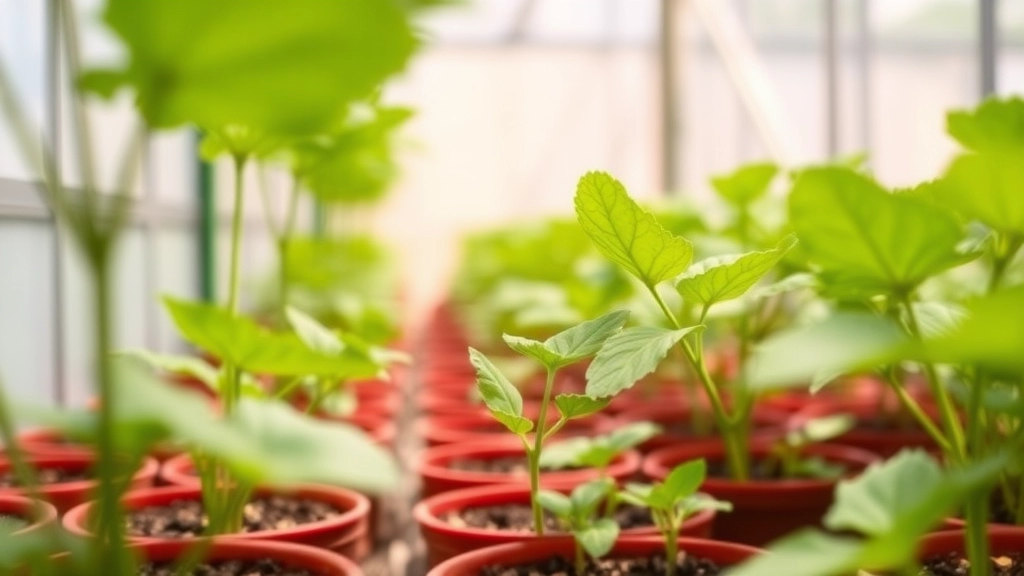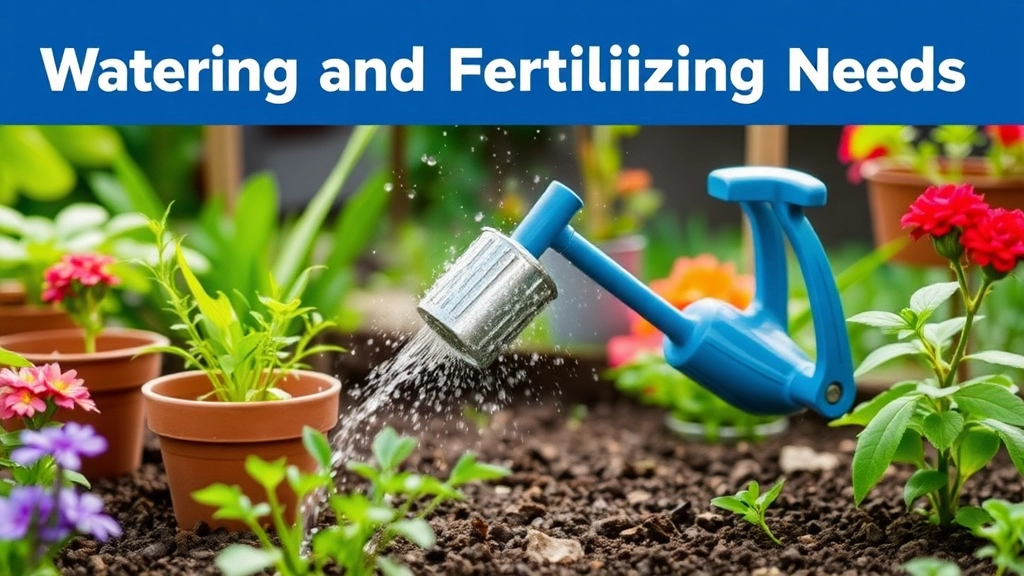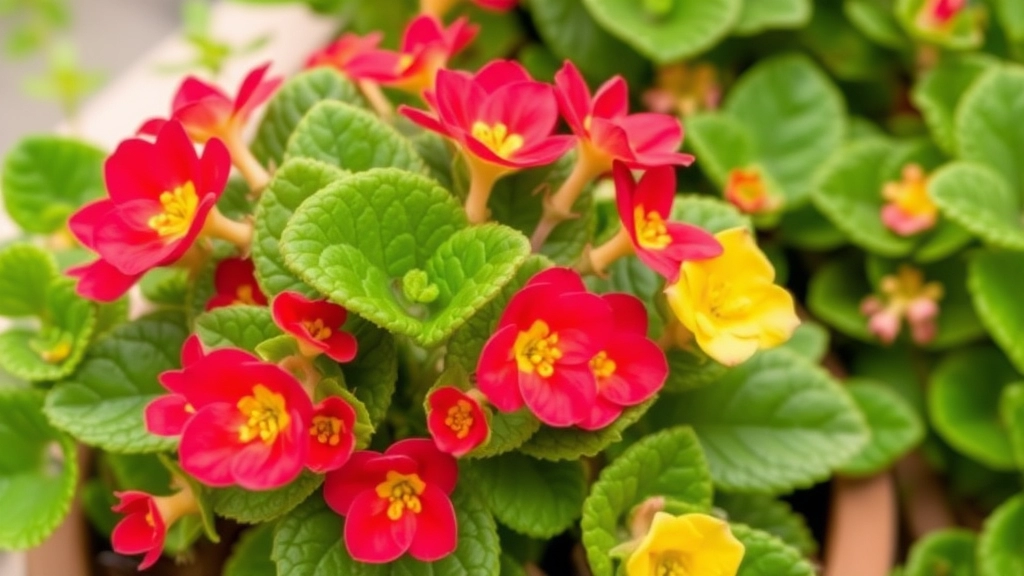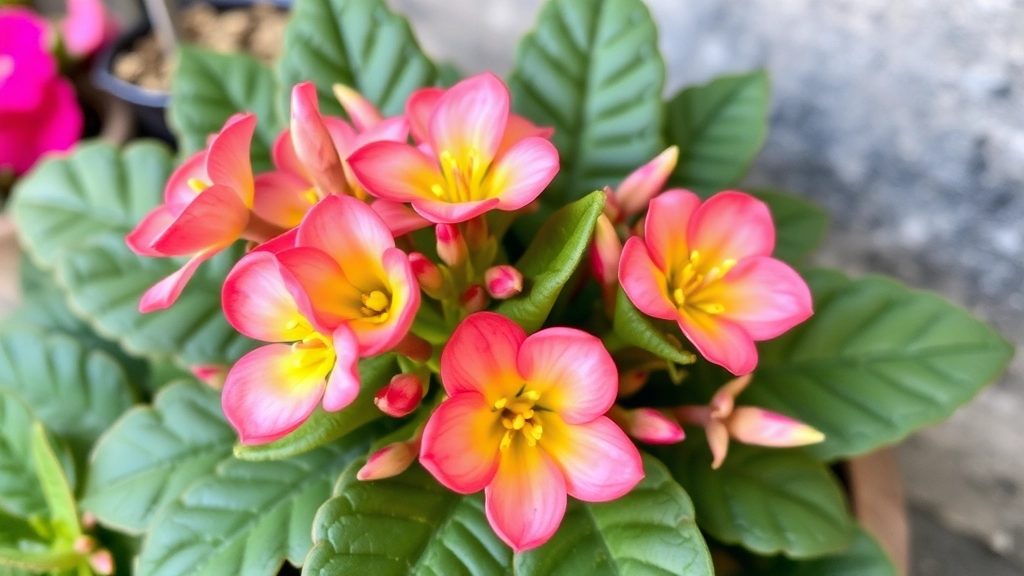Kalanchoe Mother of Thousands
The Kalanchoe Mother of Thousands, also known as Kalanchoe daigremontiana, is a fascinating succulent that captivates gardening enthusiasts with its unique ability to produce plantlets along the edges of its leaves. This characteristic makes it not only a stunning addition to any plant collection but also a subject of interest for those keen on propagation and plant care.
Growing Conditions
Understanding the ideal growing conditions for the Kalanchoe Mother of Thousands is crucial for its healthy development. This includes knowing the right light, temperature, and humidity levels, as well as the best soil types and watering schedules.
Important Considerations
- Invasive Nature: Be aware of its potential to spread.
- Toxicity: It can be toxic to pets and humans, ensuring safe and responsible cultivation.
Characteristics of the Kalanchoe Mother of Thousands
Are you curious about the unique traits of the Kalanchoe Mother of Thousands? This fascinating succulent is not just visually appealing; it also boasts several characteristics that make it a popular choice among plant enthusiasts.
The Kalanchoe Mother of Thousands, scientifically known as Kalanchoe daigremontiana, is renowned for its remarkable ability to produce numerous tiny plantlets along its leaf edges. These plantlets, often referred to as “pups,” can easily take root, leading to a rapid increase in the plant’s population. Here are some key characteristics:
- Leaf Structure: The leaves are thick, fleshy, and typically have a serrated edge, creating a striking visual effect.
- Growth Habit: This plant can grow up to 1 meter in height, with a bushy appearance. Its upright growth is complemented by its cascading pups.
- Flowering: When in bloom, it produces clusters of tubular, pink or orange flowers, adding an extra layer of beauty to its already vibrant presence.
- Hardiness: The Kalanchoe Mother of Thousands is a hardy plant, capable of thriving in a range of conditions, making it suitable for both indoor and outdoor settings.
Understanding these characteristics is essential for anyone considering adding this plant to their collection. Its unique propagation method and striking appearance can certainly enhance any space. For more detailed care tips, you might want to check out our comprehensive guide on caring and propagating Kalanchoe Mother of Thousands. Additionally, if you’re interested in other varieties, our top Kalanchoe succulent varieties and care tips can provide further insights.
Ideal Growing Conditions: Light, Temperature, and Humidity

So, you’ve got your Kalanchoe Mother of Thousands, and you’re wondering how to keep it thriving?
Well, let’s dive into the ideal conditions it craves.
Light
- Bright, Indirect Light: This plant loves bright light but steer clear of direct sunlight, which can scorch those delicate leaves.
- South or West Facing Windows: If you’ve got a sunny spot, place it there. Just remember to rotate the pot occasionally for even growth.
Temperature
- Warmth is Key: Kalanchoes thrive in temperatures between 20°C to 25°C (68°F to 77°F).
- Avoid Cold Drafts: Keep it away from chilly windows or air conditioning vents. They’re not fans of sudden temperature drops.
Humidity
- Low to Moderate Humidity: These plants are pretty adaptable but prefer drier air.
- No Need for Misting: Unlike some tropical plants, Kalanchoes don’t need extra humidity. In fact, too much can lead to rot.
Quick Recap
- Bright, indirect light is a must.
- Keep it warm and away from cold drafts.
- Low humidity is ideal.
Best Soil Types for Kalanchoe Plants
When it comes to ensuring your Kalanchoe Mother of Thousands thrives, the right soil is crucial. Many plant enthusiasts often wonder what type of soil best supports this unique succulent.
Ideal Soil Characteristics:
- Well-Draining: Kalanchoe plants require soil that drains well to prevent root rot.
- Sandy or Gritty Texture: A mix of sand or perlite helps achieve the necessary drainage.
- Slightly Acidic to Neutral pH: Aim for a pH level between 6.0 and 7.0 for optimal growth.
Recommended Soil Mixes:
- Cactus Mix: Pre-packaged cactus soil is an excellent choice, as it’s designed for succulents and cacti, promoting drainage.
- DIY Mix: If you prefer to create your own soil, combine the following:
- 2 parts potting soil
- 1 part perlite or coarse sand
- 1 part pumice (optional for extra drainage)
- Commercial Succulent Mix: Many garden centres offer pre-mixed soil specifically for succulents, which can save you time.
Using the right soil not only supports healthy roots but also encourages vibrant growth. For more detailed tips on ensuring your Kalanchoe Mother of Thousands stays healthy, check out our complete guide to caring for Kalanchoe Mother of Millions. Additionally, if you’re interested in learning about other Kalanchoe varieties, our top Kalanchoe succulents with red flowers article might be of interest.
Watering and Fertilizing Needs

When it comes to caring for your Kalanchoe Mother of Thousands, understanding its watering and fertilizing needs is crucial for ensuring healthy growth.
Watering Requirements
Kalanchoe plants thrive in well-draining conditions, so it’s essential to strike the right balance with watering. Overwatering can lead to root rot, while underwatering can stress the plant. Here are some practical tips:
- Frequency: Water your Kalanchoe every 2-3 weeks during the growing season (spring and summer). Reduce to once a month in the dormant winter months.
- Method: Always check the top inch of the soil; if it feels dry, it’s time to water. Water deeply until it drains from the bottom of the pot.
- Signs of Overwatering: Yellowing leaves and mushy stems are clear indicators. If you notice these, cut back on watering immediately.
Fertilizing Needs
Fertilizing your Kalanchoe can promote vibrant growth and flowering. Here’s how to do it effectively:
- Type of Fertilizer: Use a balanced, water-soluble fertilizer diluted to half strength.
- Frequency: Fertilize once a month during the growing season. Avoid fertilizing in the winter when the plant is dormant.
- Application: Apply the fertilizer directly to moist soil to prevent root burn.
How to Propagate Kalanchoe Mother of Thousands
If you’ve been captivated by the unique charm of the Kalanchoe Mother of Thousands, you might be wondering how to propagate this fascinating plant. Propagation is not only an economical way to expand your collection but also a rewarding experience.
Common Problems and Solutions for Kalanchoe Care

So, you’ve got your Kalanchoe Mother of Thousands, and it’s looking all cute and green. But wait—what’s that? Yellow leaves? Droopy stems? Don’t fret; you’re not alone. These beauties can face a few hiccups along the way.
1. Overwatering
One of the biggest issues is overwatering. Kalanchoes love dry soil. If you notice yellowing leaves or mushy stems, it’s a sign you might be watering too much.
- Solution: Let the soil dry out completely between waterings. Stick your finger in the soil; if it feels dry an inch down, it’s time for a drink.
2. Underwatering
On the flip side, underwatering can also be a problem. If your leaves look shrivelled or are dropping off, it’s thirsty work.
- Solution: Give it a good soak! Ensure water drains out of the pot’s bottom.
3. Pests
Pests like mealybugs and aphids can sneak in and wreak havoc. Look for sticky residue or webbing.
- Solution: Wipe the leaves with a damp cloth or spray with insecticidal soap. Neem oil is also a great natural option.
4. Too Much Sunlight
While Kalanchoes enjoy bright light, too much direct sunlight can scorch their leaves.
- Solution: Move your plant to a spot with bright, indirect light. A south or east-facing window is usually ideal.
5. Not Enough Light
Conversely, if your plant is stretching towards the light or has sparse leaves, it might be craving more sunshine.
- Solution: Increase its exposure to bright, indirect light.
6. Soil Issues
Using the wrong type of soil can lead to drainage problems. If your plant is sitting in soggy soil, it’s not going to be happy.
- Solution: Use a well-draining cactus or succulent mix. You can even mix in perlite or sand for extra drainage.
7. Temperature Fluctuations
Kalanchoes prefer stable temperatures. Sudden changes can stress them out.
- Solution: Keep them in a spot where temperatures range between 15-24°C (60-75°F). Avoid cold drafts.
As we delve into the care of the Kalanchoe Mother of Thousands, one pressing concern arises: its tendency to become invasive.
This plant, while stunning, can quickly spread beyond its intended space, leading to potential chaos in your garden or home.
Here’s how to manage its growth effectively:
– **Regular Monitoring:** Keep an eye on your Kalanchoe and its surrounding area. Check for new plantlets sprouting up, as they can take root quite easily.
– **Containment Strategies:**
– **Use Pots:** Consider [planting in pots](https://planthq.org/how-to-plant-kalanchoe-in-a-pot-stepbystep-guide/) rather than directly in the ground. This limits its spread and allows for easier management.
– **Barriers:** If planted in the garden, use physical barriers like garden edging to restrict its growth.
– **Controlled Propagation:**
– Limit the number of plantlets you allow to grow. Remove excess to prevent overcrowding.
– If you want to propagate, do so mindfully, ensuring you don’t overwhelm your space.
– **Timely Pruning:** Regularly prune back any unwanted growth. This not only keeps the plant in check but also encourages healthier development.
– **Seasonal Checks:** During the growing season, conduct a thorough check every few weeks. This proactive approach can save you from a more extensive cleanup later.
By implementing these strategies, you can enjoy the beauty of the Kalanchoe Mother of Thousands while keeping its invasive tendencies at bay. For more detailed information on its care, you might find this [varieties care guide](https://planthq.org/kalanchoe-mother-of-thousands-varieties-care-guide/) helpful.
Toxicity Warnings and Safety Precautions
Now that we’ve covered how to care for your Kalanchoe Mother of Thousands, it’s essential to talk about a crucial aspect that many plant lovers overlook: toxicity.
Is Kalanchoe Toxic?
If you’re a pet owner or have small children, you might be wondering if this beautiful plant poses any risks. The short answer is yes; Kalanchoe is considered toxic.
Here’s what you need to know:
- Toxic Components: The plant contains compounds called bufadienolides, which can affect the heart if ingested.
- Symptoms of Ingestion: If a pet or child consumes any part of the plant, they might experience symptoms like:
- Vomiting
- Diarrhoea
- Lethargy
- Abnormal heart rhythms
Safety Precautions
To keep your home safe while enjoying your Kalanchoe, consider these tips:
- Placement: Keep your plant out of reach of pets and children. High shelves or hanging planters are great options.
- Education: Teach kids about the plant and why they shouldn’t touch or eat it.
- Emergency Plan: Familiarise yourself with the nearest vet or poison control centre in case of accidental ingestion.
- Wash Hands: After handling the plant, wash your hands to avoid any accidental transfer of toxins.
By taking these simple precautions, you can enjoy your Kalanchoe Mother of Thousands without worry.
Pruning and Repotting Tips for Healthy Growth
When caring for your Kalanchoe Mother of Thousands, pruning and repotting play crucial roles in maintaining its health and vibrancy.
Why Prune Your Kalanchoe?
Pruning is essential for several reasons:
- Promotes Air Circulation: Removing dead or overcrowded leaves helps improve airflow, reducing the risk of diseases.
- Encourages Growth: Cutting back leggy or overgrown stems encourages new growth, making your plant appear fuller.
- Controls Invasiveness: Since Kalanchoe Mother of Thousands can become invasive, regular pruning helps manage its spread.
Pruning Tips
- Tools: Use clean, sharp scissors or pruning shears to avoid damaging the plant.
- Timing: Prune in spring or early summer when the plant is actively growing.
- Technique:
- Remove any dead, yellowing, or damaged leaves.
- Cut back stems to just above a leaf node to encourage new growth.
- Aim to remove no more than one-third of the plant at a time to avoid shock.
Repotting Your Kalanchoe
Repotting is another vital aspect of Kalanchoe care, especially as it grows.
- When to Repot: If you notice roots coming out of the drainage holes, it’s time to repot. Typically, this is every 1-2 years.
- Choosing a Pot: Select a pot that is one size larger than the current one, ensuring good drainage.
- Soil: Use a well-draining cactus or succulent mix to prevent root rot.
Repotting Steps
- Remove the Plant: Gently take your Kalanchoe out of its current pot.
- Inspect Roots: Trim any damaged roots and remove excess soil.
- Add Soil: Place a layer of fresh soil at the bottom of the new pot.
- Position the Plant: Set your Kalanchoe in the centre and fill in with soil, firming it gently around the roots.
- Water: After repotting, water lightly to help settle the soil.
For more detailed guidance on keeping your Kalanchoe Mother of Thousands healthy, check out our care guide. Additionally, if you’re interested in exploring other varieties, our Kalanchoe species guide offers extensive information.
FAQs about Kalanchoe Mother of Thousands
What are the ideal light conditions for Kalanchoe Mother of Thousands?
Kalanchoe Mother of Thousands thrives in bright, indirect light. Avoid direct sunlight as it can scorch the leaves. A south or west-facing window is ideal, and remember to rotate the pot occasionally for even growth.
What temperature range is best for Kalanchoe Mother of Thousands?
This plant prefers temperatures between 20°C to 25°C (68°F to 77°F). Keep it away from cold drafts and sudden temperature drops.
Does Kalanchoe Mother of Thousands need high humidity?
No, Kalanchoe Mother of Thousands prefers low to moderate humidity. It does not require misting, and too much humidity can lead to rot.
How often should I water my Kalanchoe Mother of Thousands?
Water your Kalanchoe every 2-3 weeks during the growing season (spring and summer) and reduce to once a month in the dormant winter months. Always check the top inch of the soil; if it feels dry, it’s time to water.
What kind of fertilizer should I use for Kalanchoe Mother of Thousands?
Use a balanced, water-soluble fertilizer diluted to half strength. Fertilize once a month during the growing season and avoid fertilizing in the winter.
What should I do if my Kalanchoe Mother of Thousands has yellow leaves?
Yellow leaves often indicate overwatering. Let the soil dry out completely between waterings and ensure proper drainage.
How can I treat pests on my Kalanchoe Mother of Thousands?
Common pests include mealybugs and aphids. Wipe the leaves with a damp cloth or spray with insecticidal soap. Neem oil is also an effective natural option.
What are the signs of overwatering and underwatering?
Overwatering signs include yellowing leaves and mushy stems. Underwatering signs include shrivelled leaves and dropping leaves. Adjust your watering schedule accordingly.
Is Kalanchoe Mother of Thousands toxic?
Yes, Kalanchoe is considered toxic. It contains compounds called bufadienolides, which can affect the heart if ingested. Symptoms of ingestion include vomiting, diarrhoea, lethargy, and abnormal heart rhythms.
What precautions should I take if I have pets or children?
Keep the plant out of reach of pets and children, such as on high shelves or in hanging planters. Teach kids not to touch or eat the plant, and be familiar with the nearest vet or poison control centre in case of accidental ingestion. Always wash your hands after handling the plant.
References
-
Growing Kalanchoe Mother of Thousands: Complete Guide
-
Kalanchoe Care: Tips for Growing Kalanchoe Plants
-
Kalanchoe Mother of Thousands: How to Grow & Care
